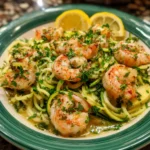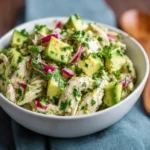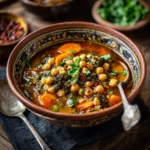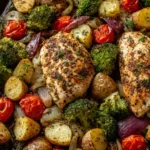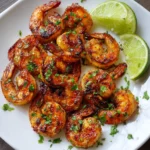Baked Salmon with Dill Sauce: A Delightful and Nutritious Seafood Dish
Baked salmon with dill sauce is a timeless culinary classic that combines the rich, buttery flavor of salmon with the bright, herbaceous notes of fresh dill. Loved by home cooks and professional chefs alike, this dish strikes the perfect balance between elegance and simplicity. Whether you’re preparing a romantic dinner for two or serving guests at a weekend brunch, baked salmon with dill sauce offers both visual appeal and exceptional taste. Its reputation as a healthy, omega-3-rich meal makes it a favorite among health-conscious individuals. In this comprehensive guide, we’ll explore everything you need to know about creating the perfect baked salmon with dill sauce — from its historical roots to step-by-step cooking instructions, nutritional insights, and creative variations.
The History of Baked Salmon with Dill Sauce
Salmon has been a staple in coastal and northern European diets for centuries, particularly in Scandinavian countries such as Norway, Sweden, and Iceland, where cold waters yield some of the world’s finest wild-caught salmon. The use of dill in Scandinavian cuisine dates back to ancient times when herbs were used not only for flavor but also for their preservative qualities. Dill, known for its feathery green leaves and aromatic seeds, was commonly paired with fish to enhance taste and aid digestion.
In traditional Nordic households, salmon was often cured, smoked, or simply pan-seared. However, as ovens became more accessible in the 19th and 20th centuries, baking emerged as a popular method for preparing fish due to its ability to retain moisture while developing a delicate crust. The combination of baked salmon and dill sauce gained popularity across Europe and later in North America during the mid-20th century, coinciding with a growing interest in heart-healthy diets and Mediterranean-inspired cuisine.
The modern version of baked salmon with dill sauce reflects a fusion of traditional Nordic flavors with contemporary culinary techniques. Today, it’s celebrated globally as a gourmet yet approachable dish that highlights the natural richness of salmon and the refreshing zest of dill, often enriched with creamy dairy components like sour cream or Greek yogurt.
Ingredients Breakdown
The beauty of baked salmon with dill sauce lies in its simple yet high-quality ingredients. Each component plays a crucial role in building layers of flavor, texture, and nutrition. Below is a detailed breakdown of the key ingredients:
- Salmon Fillets: Opt for skin-on, center-cut fillets for even cooking and optimal moisture retention. Wild-caught salmon offers a richer flavor and firmer texture, while farmed salmon tends to be fattier and more tender. Look for vibrant pink-orange flesh with firm consistency and no strong odor.
- Fresh Dill: Fresh dill is essential for authentic flavor. Its citrusy, slightly anise-like taste complements the oiliness of salmon perfectly. Use both the feathery fronds and tender stems for maximum aroma.
- Lemon: Lemon juice adds brightness and acidity, which cuts through the richness of the salmon and sauce. Lemon zest enhances the aromatic profile without adding extra liquid.
- Garlic: Minced garlic provides a subtle pungency that deepens the overall flavor complexity. Roasting mellows its sharpness beautifully.
- Olive Oil: Extra virgin olive oil helps form a flavorful glaze on the salmon and prevents drying during baking. It also carries fat-soluble nutrients from the herbs and lemon.
- Salt and Black Pepper: Essential seasonings that enhance all other flavors. Use flaky sea salt for finishing to add texture.
- Sour Cream or Greek Yogurt (for the sauce): These creamy bases give the dill sauce its luxurious texture. Sour cream offers tanginess and richness; Greek yogurt provides a lighter, protein-packed alternative with similar creaminess.
- Dijon Mustard (optional): Adds depth and a hint of spice to the sauce, helping emulsify the ingredients.
- Shallot or Red Onion (optional): Finely minced shallots add mild sweetness and a touch of bite to the sauce without overpowering the dill.
- Capars or Pickles (optional): For a briny twist, capers or finely chopped cornichons can be stirred into the sauce to elevate its complexity.
Step-by-Step Recipe
Follow these detailed steps to create a restaurant-quality baked salmon with dill sauce right in your own kitchen:
- Preheat the Oven: Set your oven to 375°F (190°C). This temperature ensures gentle, even cooking that keeps the salmon moist while allowing the surface to develop a light golden hue.
- Prepare the Baking Pan: Line a rimmed baking sheet with parchment paper or lightly grease it with olive oil or non-stick spray. Alternatively, use a glass or ceramic baking dish for easier cleanup.
- Season the Salmon: Pat the salmon fillets dry with paper towels — this helps the seasoning adhere and promotes better browning. Place them skin-side down on the prepared pan. Drizzle each fillet with about ½ tablespoon of olive oil. Sprinkle evenly with salt, freshly ground black pepper, and minced garlic. Squeeze fresh lemon juice over the top and grate a small amount of lemon zest for added fragrance.
- Add Fresh Dill: Scatter a generous handful of fresh dill sprigs over and around the fillets. You can tuck some under the fish as well to infuse flavor from below.
- Bake the Salmon: Transfer the pan to the preheated oven. Bake for 12–15 minutes, depending on the thickness of the fillets. Thicker cuts may require up to 18 minutes. The salmon is done when it flakes easily with a fork and reaches an internal temperature of 145°F (63°C) at the thickest part. Avoid overcooking to prevent dryness.
- Rest the Fish: Remove the salmon from the oven and let it rest for 3–5 minutes. This allows the juices to redistribute, resulting in a more tender bite.
- Prepare the Dill Sauce: While the salmon bakes, make the sauce. In a medium bowl, combine ¾ cup of sour cream or Greek yogurt, 2 tablespoons of finely chopped fresh dill, 1 teaspoon of lemon juice, ½ teaspoon of Dijon mustard (if using), 1 tablespoon of finely minced shallot or red onion, and a pinch of salt and pepper. Whisk until smooth. Taste and adjust seasoning as needed. For a thinner consistency, stir in a teaspoon of milk, water, or additional lemon juice.
- Serve: Plate the salmon fillets skin-side down (or remove the skin if preferred). Spoon a generous dollop of dill sauce over each portion. Garnish with extra dill fronds and a lemon wedge for presentation.
Tips for Perfect Baked Salmon with Dill Sauce
- Don’t Overcook the Salmon: One of the most common mistakes is overbaking. Salmon continues to cook slightly after removal from the oven. Aim for slightly translucent in the very center when checking doneness — residual heat will finish the process.
- Use Fresh Herbs: Dried dill lacks the vibrancy and freshness required for this dish. Always opt for fresh dill whenever possible. If absolutely necessary, substitute 1 teaspoon of dried dill for every 1 tablespoon of fresh — but expect a less pronounced flavor.
- Room Temperature Start: Let the salmon sit at room temperature for 10–15 minutes before baking. Cold fish straight from the fridge may cook unevenly.
- Skin On vs. Skin Off: Cooking with the skin on protects the delicate flesh and helps hold the fillet together. The skin can be easily removed after baking if desired.
- Make Ahead Sauce: The dill sauce tastes even better when made a few hours in advance, allowing the flavors to meld. Store covered in the refrigerator and bring to room temperature before serving.
- Check for Pin Bones: Run your fingers along the surface of the salmon fillet to feel for any remaining pin bones. Use tweezers or needle-nose pliers to gently pull them out before cooking.
- Enhance Flavor with Aromatics: Add lemon slices, whole garlic cloves, or fresh herbs like thyme or parsley to the baking tray for additional flavor infusion.
Variations and Customizations
Baked salmon with dill sauce is highly adaptable to different tastes, dietary needs, and occasions. Here are several delicious variations to inspire your next meal:
- Herb-Crusted Salmon: Before baking, coat the top of the fillets with a mixture of breadcrumbs, grated Parmesan, chopped dill, lemon zest, and olive oil for a crispy crust.
- Honey-Dijon Glazed Salmon: Brush the salmon with a blend of honey, Dijon mustard, lemon juice, and olive oil before baking for a sweet-and-tangy twist.
- Asian-Inspired Dill Sauce: Replace sour cream with plain coconut yogurt and add a splash of soy sauce, grated ginger, and a dash of sesame oil for an East-meets-Nordic fusion.
- Dairy-Free Dill Sauce: Use cashew cream, avocado, or blended silken tofu as a base for a rich, plant-based alternative. Add lemon juice and fresh dill for authenticity.
- Smoked Salmon Variation: Serve cold-smoked salmon on rye bread or cucumber rounds with warm dill sauce for an elegant appetizer.
- Spicy Kick: Stir a pinch of red pepper flakes or a few drops of hot sauce into the dill sauce for those who enjoy heat.
- With Vegetables: Roast asparagus, cherry tomatoes, zucchini, or bell peppers alongside the salmon on the same tray for a complete one-pan meal.
- Wine Pairing Addition: Deglaze the baking pan with a splash of dry white wine after removing the salmon, then reduce and mix into the sauce for a sophisticated upgrade.
Health Considerations and Nutritional Value
Baked salmon with dill sauce isn’t just delicious — it’s exceptionally nutritious. Here’s why this dish deserves a regular spot in a balanced diet:
- Rich in Omega-3 Fatty Acids: Salmon is one of the best sources of EPA and DHA, essential fatty acids linked to reduced inflammation, improved heart health, and enhanced brain function.
- High-Quality Protein: A 4-ounce serving of salmon contains about 23 grams of complete protein, supporting muscle repair, satiety, and metabolic health.
- Vitamin D Powerhouse: Salmon is naturally rich in vitamin D, crucial for immune function, bone health, and mood regulation — especially important in winter months.
- B Vitamins: Loaded with B12, niacin, and selenium, salmon supports energy production, nerve function, and antioxidant defense.
- Low in Carbohydrates: This dish is ideal for low-carb, keto, and paleo diets, especially when served with non-starchy vegetables.
- Dill Benefits: Fresh dill contains antioxidants, flavonoids, and monoterpenes that may support digestive health and exhibit antimicrobial properties.
- Sauce Modifications: To reduce calories and fat, use low-fat Greek yogurt instead of sour cream. For lactose-sensitive individuals, dairy-free alternatives work well without sacrificing creaminess.
- Mind Mercury Levels: While salmon is generally low in mercury compared to other fish like swordfish or tuna, pregnant women and young children should still consume it in moderation (2–3 servings per week).
Nutritionally speaking, a typical serving (one 6-ounce salmon fillet with 2 tablespoons of dill sauce) contains approximately:
- Calories: 380–420
- Protein: 34–38g
- Fat: 25–28g (mostly healthy unsaturated fats)
- Carbohydrates: 2–4g
- Fiber: 0–1g
- Sodium: 300–500mg (depending on added salt)
Ingredients
Serves 4
For the Baked Salmon:
- 4 salmon fillets (about 6 oz each), skin-on
- 2 tablespoons extra virgin olive oil
- 1 large lemon (juice and zest)
- 3 cloves garlic, minced
- 1 teaspoon sea salt
- ½ teaspoon freshly ground black pepper
- ¼ cup fresh dill sprigs, plus extra for garnish
For the Dill Sauce:
- ¾ cup sour cream or full-fat Greek yogurt
- 3 tablespoons fresh dill, finely chopped
- 1 teaspoon lemon juice
- 1 teaspoon Dijon mustard (optional)
- 1 tablespoon finely minced shallot or red onion
- Pinch of salt and pepper
- 1–2 teaspoons milk or water (optional, for thinning)
Directions
- Preheat oven to 375°F (190°C). Line a baking sheet with parchment paper or lightly grease it.
- Pat salmon fillets dry with paper towels. Place them skin-side down on the baking sheet.
- Drizzle olive oil over the fillets. Sprinkle with salt, pepper, and minced garlic. Squeeze half the lemon over the fish and grate the zest from one lemon half onto the fillets.
- Scatter fresh dill sprigs over the salmon. Arrange lemon slices around the fillets if desired.
- Bake for 12–15 minutes, until the salmon is opaque and flakes easily with a fork. Do not overcook.
- While the salmon bakes, prepare the dill sauce: In a bowl, combine sour cream (or Greek yogurt), chopped dill, lemon juice, Dijon mustard (if using), minced shallot, salt, and pepper. Whisk until smooth. Adjust seasoning to taste. Add milk or water if a thinner consistency is desired.
- Remove salmon from oven and let rest for 5 minutes.
- Serve each fillet with a generous spoonful of dill sauce. Garnish with extra dill and a lemon wedge.
- Enjoy immediately with roasted vegetables, quinoa, rice, or a crisp green salad.
FAQ
Can I use frozen salmon?
Yes, but thaw it completely in the refrigerator overnight before baking. Pat it very dry before seasoning to prevent excess moisture and steaming.
How do I store leftovers?
Store leftover salmon and sauce separately in airtight containers in the refrigerator for up to 2 days. Reheat salmon gently in the oven at 300°F or enjoy cold in salads.
Can I make the sauce ahead of time?
Absolutely! The dill sauce tastes better after chilling for a few hours. Make it up to one day in advance for convenience.
Is this recipe gluten-free?
Yes, as long as all ingredients used are certified gluten-free (especially check labels on sour cream or yogurt if cross-contamination is a concern).
Can I grill instead of bake?
Yes! Grill the salmon over medium heat (about 350°F) for 6–8 minutes per side, depending on thickness. Use a grill basket or foil to prevent sticking.
What sides go well with this dish?
Excellent pairings include roasted asparagus, sautéed spinach, couscous, wild rice, mashed potatoes, or a simple arugula salad with lemon vinaigrette.
Why is my salmon dry?
Overcooking is the main culprit. Use a meat thermometer and remove salmon at 140–145°F. Remember that carryover cooking will raise the temperature by a few degrees.
Summary
Baked salmon with dill sauce is a wholesome, flavorful dish that brings together the luxurious texture of salmon and the refreshing taste of fresh herbs. Easy to prepare and rich in essential nutrients, it’s perfect for everyday meals or special occasions.
With customizable options, make-ahead convenience, and endless pairing possibilities, this recipe is a must-have in any home cook’s repertoire — delivering gourmet results with minimal effort.


